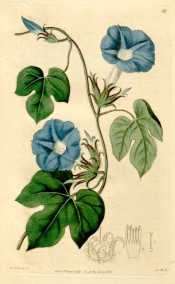Ipomoea hederacea Jacq. var. grandiflora
Frost tender, annual twining climber with slender, densely hairy stems, ovate to rounded, usually 3-lobed leaves, to 12cm long, with tapering points, and cymes of 2-5, funnel-shaped, blue, sometimes purple flowers, to 3.5cm across, with white tubes and prominent, long-tailed, green sepals, in summer. Grandiflora is an improved form with larger flowers. To 3m. [RHSE, Hortus].
Horticultural & Botanical History
‘It is seen in perfection only in the very early part of the day, and is called “the Morning Glory,” in America. The seed should be sown in the spring, with that of other annuals, and the plants treated like those of the twining kinds. The species is seldom seen in our gardens, altho’ known in them from the days of Parkinson.’ [BR f.85/1816]. Ipomoea hederacea was introduced to Britain in 1729. [JD].
History at Camden Park
Listed in the 1857 catalogue only [T.577/1857].
Notes
Published Mar 09, 2009 - 04:27 PM | Last updated Jul 16, 2010 - 03:35 PM
| Family | Convolvulaceae |
|---|---|
| Category | |
| Region of origin | Tropical regions |
| Synonyms |
|
| Common Name | Ivy-leaved Morning Glory |
| Name in the Camden Park Record | Ipomoea hederacea grandiflora |
| Confidence level | high |
